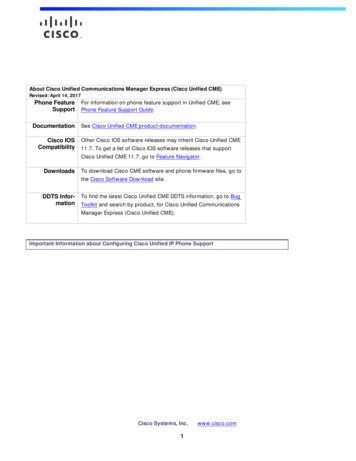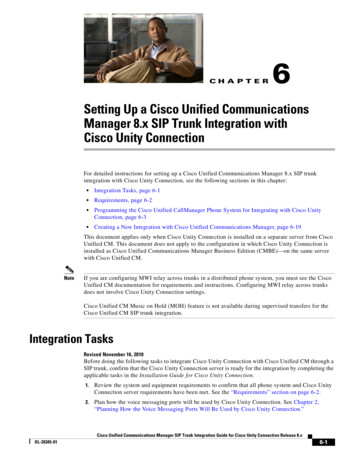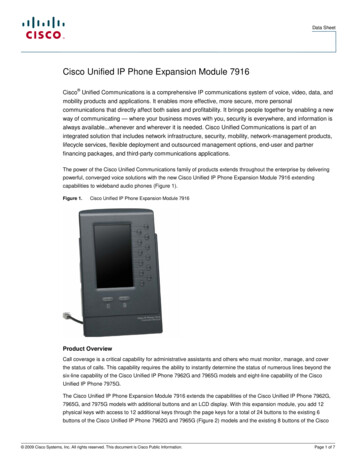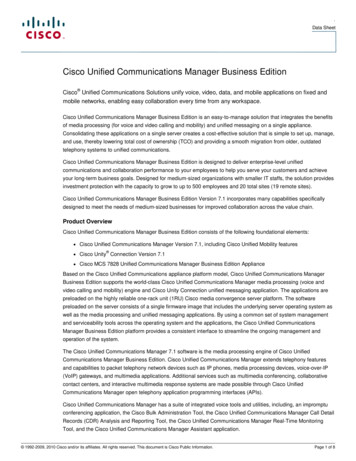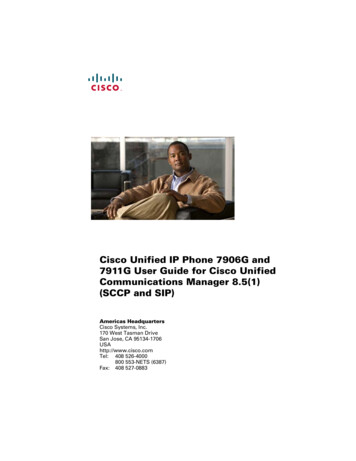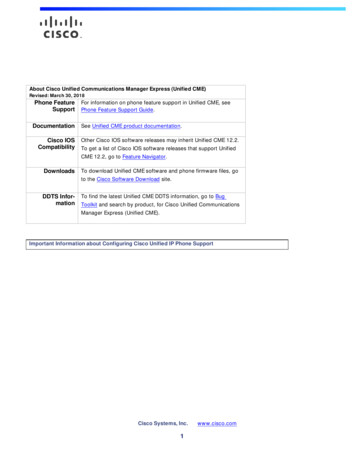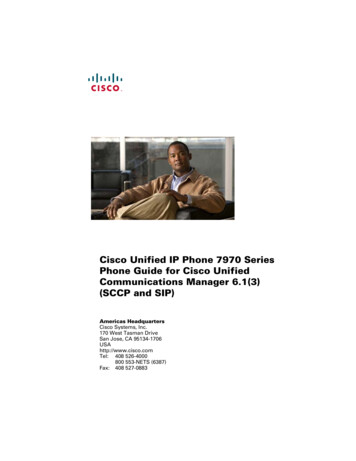
Transcription
Cisco Unified IP Phone 7970 SeriesPhone Guide for Cisco UnifiedCommunications Manager 6.1(3)(SCCP and SIP)Americas HeadquartersCisco Systems, Inc.170 West Tasman DriveSan Jose, CA 95134-1706USAhttp://www.cisco.comTel: 408 526-4000800 553-NETS (6387)Fax: 408 527-0883
Common Phone TasksSoftkey DefinitionsView online help onphonePressAbbrDialDial using a speed dial indexnumberPlace a callGo off-hook before orafter dialing a number.AnswerAnswer a callBackReturn to the previous Help topicRedial a numberPress Redial.BargeSwitch to handsetduring a callPick up the handset.Add yourself to a call on a sharedlineCallBackReceive notification when a busyextension becomes availableCancelCancel an action or exit a screenwithout applying changescBargeAdd yourself to a call on a sharedline and establish a conferenceCFwdALLSetup/cancel call forwarding.QUICK REFERENCESwitch to speaker or Pressor, thenheadset during a call hang up the handset.Mute your phonePressUse your call logsPressto choose acall log. To dial, highlighta listing and go off-hook.Edit a number.Press EditDial, or .Hold/resume a callPress Hold or Resume.Transfer call to newnumberPress Transfer, enter thenumber, then pressTransfer again.Place an intercom call Press intercom button,enter a number ifnecessary, and speak afteryou hear the tone.Start a standard (adhoc) conference callPress more Confrn, dialthe participant, then pressConfrn again.ClearDelete records or settingsCisco Unified IP Phone7970 Series forCisco UnifiedCommunicationsManager 6.1(3)(SCCP and SIP)CloseClose the current windowConfListView conference participantsConfrnCreate a conference callDeleteRemove characters to the right ofthe cursor when using EditDialSoftkey DefinitionsDialPhone Screen IconsDirTrfrsTransfer two calls to each other(SCCP only)Button IconsCommon Phone TasksCisco, Cisco Systems, the Cisco logo, and the Cisco Systems logo areregistered trademarks or trademarks of Cisco Systems, Inc. and/or its affiliatesin the United States and certain other countries. All other trademarksmentioned in this document or Website are the property of their respectiveowners. The use of the word partner does not imply a partnership relationshipbetween Cisco and any other company. (0705R) 2008 Cisco Systems, Inc. All rights reserved.OL-16993-01DetailsOpen the Details record for a(SCCP only) multiparty call in the Missed Callsand Received Calls logsDial a phone numberDNDTurn on/off Do Not Disturb(DND)EditDialEdit a number in a call logEndCallDisconnect the current call or thecurrent intercom callEraseReset settings to their defaultsExitReturn to the previous screen
GPickUpAnswer a call ringing in anothergroupiDivertSend or redirect a call to a voicemessage systemPhone Screen IconsSpeakerphone in useLine and Call StatusVideo enabled (SCCP only)Call Forwarding enabledFeature AccessJoinJoin together existing calls to(SCCP only) create a conferenceCall on hold; remote call on holdFeature assigned to buttonLinksView related Help topicsConnected callMobility assigned to buttonMainDisplay the Help main menuIncoming callHold assigned to buttonMeetMeHost a Meet-Me conference callDisplay additional softkeysOff-hookConference assigned to buttonmoreNew CallMake a new callOn-hookTransfer assigned to buttonOPickUpAnswer a call ringing in anassociated groupShared line in usePhone service URL assigned tobuttonParkStore a call using Call ParkPickUpAnswer a call in your groupAuthenticated callQRTSubmit call problems to the systemadministratorEncrypted callRedialRedial the most recently dialednumberRemoveRemove a conference participantResumeResume a call on holdRMLstCDrop the last party added to aconference callSaveSave the chosen settingsSearchSearch for a directory listingSelectSelect a menu item or callTransferTransfer a callUpdateRefresh contentVidModeChoose a video display mode(SCCP only)Message waitingURL entry in a call log is ready toedit (SIP only)Option selectedFeature enabledBLF- monitored line is in-useBLF-monitored line is idleBLF-monitored line is ringing (BLFPickup) (SCCP only)Speed-dial, call log, or directorylisting (line status unknown)Line in Do Not Disturb (BLF feature)Idle intercom lineButton IconsMessagesServicesHelpDirectoriesOne-way intercom callSettingsTwo-way intercom callVolumeAudio or Video ModeSpeaker Delete entered charactersHandset in useMute Move through entered charactersHeadset in useHeadset
ContentsGetting Started 9Using this Guide 9Finding Additional Information 10Accessing Cisco Unified IP Phone 7900 Series eLearning Tutorials 10Safety and Performance Information 10Cisco Product Security Overview 11Accessibility Features 11Connecting Your Phone 12An Overview of Your Phone 15Understanding Buttons and Hardware 15Understanding Lines vs. Calls 18Understanding Line and Call Icons 19Understanding Touchscreen Features 20Choosing Touchscreen Items 21Cleaning and Maintaining the Touchscreen 21Understanding Feature Buttons and Menus 22Accessing the Help System on Your Phone 23Understanding Feature Availability 23Understanding SIP vs. SCCP 24Basic Call Handling 25Placing a Call—Basic Options 25Placing a Call—Additional Options 26Answering a Call 29Ending a Call 30Using Hold and Resume 31Cisco Unified IP Phone 7970 Series Phone Guide for Cisco Unified Communications Manager 6.1(3)-5
Using Mute 32Switching Between Multiple Calls 32Switching an In-Progress Call to Another Phone 33Viewing Multiple Calls 33Transferring Calls 34Sending a Call to a Voice Message System 35Forwarding Calls to Another Number 35Using Do Not Disturb 36Making Conference Calls 37Using Conference Features 37Using Conference 38Using Join 39Using cBarge 40Using Meet-Me 40Viewing or Removing Conference Participants 41Placing or Receiving Intercom Calls 41Advanced Call Handling 43Speed Dialing 43Picking Up a Redirected Call on Your Phone 44Storing and Retrieving Parked Calls 45Logging Out of Hunt Groups 46Using a Shared Line 46Understanding Shared Lines 47Using Barge to Add Yourself to a Shared-Line Call 47Understanding Barge Features 47Using Barge Features 48Preventing Others from Viewing or Barging a Shared-Line Call 49Using BLF to Determine a Line State 50Making and Receiving Secure Calls 51Tracing Suspicious Calls 51Prioritizing Critical Calls 52Using Cisco Extension Mobility 53-6OL-16993-01
Managing Business Calls Using a Single Phone Number 54Using a Handset, Headset, and Speakerphone 56Obtaining a Headset 57Using AutoAnswer 57Changing Phone Settings 58Customizing Rings and Message Indicators 58Customizing the Touchscreen 59Using Call Logs and Directories 60Using Call Logs 60Directory Dialing 62Using Corporate Directory on Your Phone 62Using Personal Directory on Your Phone 63Accessing Voice Messages 65Using the Cisco Unified CM User Options Web Pages 66Accessing Your User Options Web Pages 66Configuring Features and Services on the Web 67Using Personal Directory on the Web 67Using Your Personal Address Book on the Web 67Configuring Fast Dials on the Web 68Using the Address Book Synchronization Tool 69Setting Up Speed Dials on the Web 69Setting Up Phone Services on the Web 71Controlling User Settings on the Web 72Controlling Line Settings on the Web 73Setting Up Phones and Access Lists for Mobile Connect 75Using Cisco WebDialer 77Understanding Additional Configuration Options 79Troubleshooting Your Phone 81General Troubleshooting 81Cisco Unified IP Phone 7970 Series Phone Guide for Cisco Unified Communications Manager 6.1(3)-7
Viewing Phone Administration Data 82Using the Quality Reporting Tool 82Cisco One-Year Limited Hardware Warranty Terms 83Index 85-8OL-16993-01
Getting StartedUsing this GuideThis guide provides you with an overview of the features available on your phone. You can read itcompletely for a solid understanding of your phone’s capabilities or refer to the table below forpointers to commonly used sections.If you want to.Then.Explore your phone on your ownPressReview safety informationSee Safety and Performance Information, page 10.Connect your phoneSee Connecting Your Phone, page 12.on the phone when you need assistance.Use your phone after it is installed Start with An Overview of Your Phone, page 15.Learn what the button lights mean See Understanding Buttons and Hardware, page 15.Learn about the touchscreenSee Understanding Touchscreen Features, page 20.Make callsSee Placing a Call—Basic Options, page 25.Put calls on holdSee Using Hold and Resume, page 31.Mute callsSee Using Mute, page 32.Transfer callsSee Transferring Calls, page 34.Make conference callsSee Making Conference Calls, page 37.Set up speed dialingSee Speed Dialing, page 43.Share a phone numberSee Using a Shared Line, page 46.Use your phone as a speakerphone See Using a Handset, Headset, and Speakerphone, page 56.Change the ring volume or toneSee Changing Phone Settings, page 58.View your missed callsSee Using Call Logs, page 60.Listen to your voice messagesSee Accessing Voice Messages, page 65.See softkey and icon definitionsRefer to the Quick Reference Card in the front of this guide.Cisco Unified IP Phone 7970 Series Phone Guide for Cisco Unified Communications Manager 6.1(3)-9
Finding Additional InformationYou can access the most current Cisco Unified IP Phone documentation on the World Wide Web atthis ps379/products user guide list.htmlYou can access the Cisco website at this URL:http://www.cisco.com/International Cisco websites can be accessed from this URL:http://www.cisco.com/public/countries languages.shtmlYou can access the most current Licensing Information at this URL:http://www.cisco.com/en/US/docs/voice ip comm/cuipph/all models/openssl license/7900 ssllic.htmlAccessing Cisco Unified IP Phone 7900 Series eLearning Tutorials(SCCP phones only)Cisco Unified IP Phone 7900 Series eLearning tutorials use audio and animation to demonstrate basiccalling features. You can access eLearning tutorials online (for several phone models) from yourpersonal computer. Look for the eLearning tutorial (English only) for your phone model in thedocumentation list at the following ones/ps379/products user guide list.htmlSafety and Performance InformationRefer to these sections for information about the impact of power outages and other devices on yourCisco Unified IP Phone.Power OutageYour accessibility to emergency service through the phone is dependent on the phone being powered.If there is an interruption in the power supply, Service and Emergency Calling Service dialing will notfunction until power is restored. In the case of a power failure or disruption, you may need to reset orreconfigure equipment before using the Service or Emergency Calling Service dialing.Using External DevicesThe following information applies when you use external devices with the Cisco Unified IP Phone:Cisco recommends the use of good quality external devices (such as headsets) that are shielded againstunwanted radio frequency (RF) and audio frequency (AF) signals.-10OL-16993-01
Getting StartedDepending on the quality of these devices and their proximity to other devices such as mobile phonesor two-way radios, some audio noise may still occur. In these cases, Cisco recommends that you takeone or more of the following actions: Move the external device away from the source of the RF or AF signals. Route the external device cables away from the source of the RF or AF signals. Use shielded cables for the external device, or use cables with a better shield and connector. Shorten the length of the external device cable. Apply ferrites or other such devices on the cables for the external device.Cisco cannot guarantee the performance of the system because Cisco has no control over the qualityof external devices, cables, and connectors. The system will perform adequately when suitable devicesare attached using good quality cables and connectors.CautionIn European Union countries, use only external speakers, microphones, and headsets thatare fully compliant with the EMC Directive [89/336/EC].Cisco Product Security OverviewThis product contains cryptographic features and is subject to United States and local country lawsgoverning import, export, transfer and use. Delivery of Cisco cryptographic products does not implythird-party authority to import, export, distribute or use encryption. Importers, exporters, distributorsand users are responsible for compliance with U.S. and local country laws. By using this product youagree to comply with applicable laws and regulations. If you are unable to comply with U.S. and locallaws, return this product immediately.Further information regarding U.S. export regulations may be found athttp://www.access.gpo.gov/bis/ear/ear data.html.Accessibility FeaturesA list of accessibility features is available upon request. You can find more information about Ciscoaccessibility features at this URL:www.cisco.com/go/accessibilityCisco Unified IP Phone 7970 Series Phone Guide for Cisco Unified Communications Manager 6.1(3)-11
Connecting Your PhoneYour system administrator will likely connect your new Cisco Unified IP Phone to the corporate IPtelephony network. If that is not the case, refer to the graphic and table below to connect your phone.1091AUX10/100/1000 SW 10/100/1000 PCDC48V397261139518541DC adaptor port (DC48V)6Handset port2AC-to-DC power supply7Headset port3AC power cord8External speaker port9Microphone port45Network portAccess port(10/1001SW)(10/1001PC)10 Footstand button1. Your phone may show 10/100/1000.-12OL-16993-01
Connecting Your Phone185165Removing the Hookswitch Clip (Required)Before you use your phone, remove the hookswitch clip from the cradle area. With the clip removed,the hookswitch lifts slightly when you pick up the handset.Adjusting the Handset Rest (Optional)Cisco recommends adjusting the handset rest, particularly when wall-mounting the phones, as this willensure that the receiver will not readily slip out of the cradle. See the table below for instructions.1231Set the handset aside and pull the square plastic tab from the handset rest.2Rotate the tab 180 degrees.3Slide the tab back into the handset rest. An extension protrudes from the top of the rotated tab.Return the handset to the handset rest.Adjusting the Footstand (Optional)To change the angle of the phone base, adjust the footstand while pressing the footstand button.Cisco Unified IP Phone 7970 Series Phone Guide for Cisco Unified Communications Manager 6.1(3)-13
Registering with TAPSAfter your phone is connected to the network, your system administrator might ask you toauto-register your phone using TAPS (Tool for Auto-Registered Phones Support). TAPS might be usedeither for a new phone or to replace an existing phone.To register with TAPS, pick up the handset, enter the TAPS extension provided by your systemadministrator, and follow the voice prompts. You might need to enter your entire extension, includingthe area code. After your phone displays a confirmation message, hang up. The phone will re-start.Headset InformationTo use a headset, connect it to the headset port on the back of your phone.Although Cisco Systems performs some internal testing of third-party headsets for use with theCisco Unified IP Phones, Cisco does not certify or support products from headset or handset vendors.Because of the inherent environmental and hardware inconsistencies in the locations whereCisco Unified IP Phones are deployed, there is not a single “best” solution that is optimal for allenvironments. Cisco recommends that customers test the headsets that work best in their environmentbefore deploying a large number of units in their network.In some instances, the mechanics or electronics of various headsets can cause remote parties to hearan echo of their own voice when they speak to Cisco Unified IP Phone users.Cisco Systems recommends the use of good quality external devices, like headsets that are screenedagainst unwanted radio frequency (RF) and audio frequency (AF) signals. Depending on the quality ofthese devices and their proximity to other devices such as cell phones and two-way radios, some audionoise may still occur.The primary reason that support of a headset would be inappropriate for the Cisco Unified IP Phoneis the potential for an audible hum. This hum can either be heard by the remote party or by both theremote party and you, the Cisco Unified IP Phone user. Some potential humming or buzzing soundscan be caused by a range of outside sources, for example, electric lights, being near electric motors,large PC monitors. In some cases, a hum experienced by a user may be reduced or eliminated by usinga local power cube or power injector.Audio Quality Subjective to the UserBeyond the physical, mechanical and technical performance, the audio portion of a headset mustsound good to you (the user) and to the party on the far end. Sound is subjective and Cisco cannotguarantee the performance of any headsets or handsets, but some of the headsets and handsets on thesites listed below have been reported to perform well with Cisco Unified IP Phones.Nevertheless, it is ultimately still the customer’s responsibility to test this equipment in their ownenvironment to determine suitable performance.For information about headsets, nics.comhttp://www.jabra.com-14OL-16993-01
An Overview of Your PhoneAn Overview of Your PhoneYour 7970 Series Cisco Unified IP Phone is a full-feature telephone that provides voice communicationover the same data network that your computer uses, allowing you to place and receive phone calls,put calls on hold, transfer calls, make conference calls, and so on.In addition to basic call-handling features, your 7970 Series Cisco Unified IP Phone can provideenhanced productivity features that extend your call-handling capabilities. Depending onconfiguration, your phone supports: Access to network data, XML applications, and web-based services. Online customizing of phone features and services from your Cisco Unified CM User Options webpages. A comprehensive online help system that displays information on the phone screen.Understanding Buttons and HardwareYou can use the graphic table below to identify buttons and hardware on your phone.Cisco Unified IP Phone 7970 Series Phone Guide for Cisco Unified Communications Manager 6.1(3)-15
16171234915-16141312 11 106818642857OL-16993-01
An Overview of Your Phone1ItemDescriptionFor more information, see.ProgrammablebuttonsDepending on configuration, programmablebuttons provide access to: Phone lines and intercom lines (linebuttons) Speed-dial numbers (speed-dial buttons,including the BLF speed-dial feature) UnderstandingTouchscreen Features,page 20 Basic Call Handling,page 25 Speed Dialing, page 43 Web-based services (for example, aPersonal Address Book button) Using a Shared Line,page 46 Call features (for example, a Privacy,Hold, or Transfer button) Using BLF toDetermine a Line State,page 50Buttons illuminate to indicate status:Green, steady—Active call ortwo-way intercom call Placing or ReceivingIntercom Calls, page 41Green, flashing—Held callAmber, steady—Privacy in use,one-way intercom call, DNDactive, or logged into Hunt GroupAmber, flashing—Incoming call orreverting callRed, steady—Remote line in use(shared line or BLF status)Red, flashing—Remote call onhold2Footstand buttonAllows you to adjust the angle of the phonebase.Adjusting the Footstand(Optional), page 133Display buttonAwakens the touchscreen from sleep mode or Cleaning and Maintainingthe Touchscreen, page 21disables it for cleaning.No color—Ready for inputGreen flashing—DisabledGreen steady—Sleep mode4Messages buttonAuto-dials your voice message service (varies Accessing Voice Messages,by service).page 655Directories buttonOpens/closes the Directories menu. Use it toaccess call logs and directories.Using Call Logs, page 60Cisco Unified IP Phone 7970 Series Phone Guide for Cisco Unified Communications Manager 6.1(3)-17
6Help buttonActivates the Help menu.Accessing the Help Systemon Your Phone, page 237Settings buttonOpens/closes the Settings menu. Use it tochange touchscreen and ring settings.Changing Phone Settings,page 588Services buttonOpens/closes the Services menu.Using the Cisco Unified CMUser Options Web Pages,page 669Volume buttonControls the handset, headset, andspeakerphone volume (off-hook) and theringer volume (on-hook).Using a Handset, Headset,and Speakerphone, page 5610 Speaker buttonToggles the speakerphone on or off. Whenthe speakerphone is on, the button is lit.Using a Handset, Headset,and Speakerphone, page 5611 Mute buttonToggles the microphone on or off. When themicrophone is muted, the button is lit.Using Mute, page 3212 Headset buttonToggles the headset on or off. When theheadset is on, the button is lit.Using a Handset, Headset,and Speakerphone, page 5613 Navigation buttonAllows you to scroll through menus andhighlight items. When the phone is on-hook,displays phone numbers from your PlacedCalls log.Using Call Logs, page 6014 KeypadAllows you to dial phone numbers, enterletters, and choose menu items.Basic Call Handling,page 2515 Softkey buttonsEach activates a softkey option (displayed on Understanding TouchscreenFeatures, page 20your touchscreen).16 Handset light stripIndicates an incoming call or new voicemessage.Accessing Voice Messages,page 6517 TouchscreenShows phone features.Understanding TouchscreenFeatures, page 20Understanding Lines vs. CallsTo avoid confusion about lines and calls, refer to these descriptions: Lines—Each corresponds to a directory number or intercom number that others can use to callyou. Your phone can support up to eight lines. To see your phone lines, look at the right side ofyour touchscreen. You have as many lines as you have directory numbers and phone line.icons-18OL-16993-01
An Overview of Your Phone Calls—Each line can support multiple calls. By default, your phone supports four connected callsper line, but your system administrator can adjust this number according to your needs. Only onecall can be active at any time; other calls are automatically placed on hold.Understanding Line and Call IconsYour phone displays icons to help you determine the line and call state.IconLine or call stateDescriptionOn-hook lineNo call activity on this line.Off-hook lineYou are dialing a number or an outgoing call is ringing.Connected callYou are connected to the other party.Ringing callA call is ringing on one of your lines.Call on holdYou have put the call on hold. See Using Hold and Resume, page 31.Remote call onholdAnother phone that shares your line has put a call on hold. See UsingHold and Resume, page 31.Remote-in-useAnother phone that shares your line has a connected call. See Usinga Shared Line, page 46.Reverting callA holding call is reverting to your phone. See Using Hold andResume, page 31.Authenticated callSee Making and Receiving Secure Calls, page 51.Encrypted callSee Making and Receiving Secure Calls, page 51.BLF- monitoredline is idleSee Using BLF to Determine a Line State, page 41.BLF- monitoredline is in-useSee Using BLF to Determine a Line State, page 41.BLF- monitoredline is ringing (BLFPickup) (SCCPonly)See Using BLF to Determine a Line State, page 41.Line in Do NotDisturb (BLF)See Using BLF to Determine a Line State, page 50.Idle Intercom lineThe intercom line is not in use. See Placing or Receiving IntercomCalls, page 41.Cisco Unified IP Phone 7970 Series Phone Guide for Cisco Unified Communications Manager 6.1(3)-19
IconLine or call stateDescriptionOne-way intercomcallThe intercom line is sending or receiving one-way audio. See Placingor Receiving Intercom Calls, page 41.Two-way intercomcallThe recipient pressed the intercom line to activate two-way audiowith the caller. See Placing or Receiving Intercom Calls, page 41.Understanding Touchscreen FeaturesThis is what your main touchscreen might look like with active calls and several feature menus open.71624318642951Primary phone Displays the phone number (directory number) for your primary phone line.line2Programmable Programmable buttonscan serve as phone line buttons, intercom linebuttons, speed-dial buttons, phone service buttons, or phone feature buttons.buttonIcons and labels indicate how these buttons are configured. For an iconindicatorsreference, see the “Phone Screen Icons” section in the Quick Reference Card atthe front of this guide.3Softkey labelsEach displays a softkey function. Softkey labels are touch-sensitive.4Status lineDisplays audio mode icons, status information, and prompts.-20OL-16993-01
An Overview of Your Phone5Call activityareaDisplays current calls per line, including caller ID, call duration, and call statefor the highlighted line (standard view). Items in this area are touch-sensitive.See Understanding Line and Call Icons, page 19, and Viewing Multiple Calls,page 33.6Phone tabIndicates call activity. Press this tab to return to the call activity area, if needed.7Feature tabsEach indicates an open feature menu. Tabs are touch-sensitive. SeeUnderstanding Feature Buttons and Menus, page 22.Choosing Touchscreen ItemsThere are three ways to choose items on your phone’s touchscreen.To choose atouchscreen item.Do this.By touchPress (or tap) touch-sensitive items on the touchscreen with your fingertip.Use only your fingertip to press the touchscreen, as using any other objectscould damage the display. Be aware that pressing a phone number can cause thephone to dial the number.By item numberPress the corresponding number on your keypad. For example, press 4 tochoose the fourth item in a menu.By scrollingPress the Navigation button to highlight an item. Press a softkey to finish theaction, or tap the item on the touchscreen with your fingertip.Cleaning and Maintaining the TouchscreenYou can use the Display buttonto disable and enable the touchscreen. The Display buttonilluminates to indicate changes in touchscreen status:Green, steady—Touchscreen is in sleep modeGreen, flashing—Touchscreen is disabledIf you want to.Then.Disable the touchscreenfor cleaningPressand hold for more than one second.flashes.The screen remains disabled for about a minute, unless you enable it.Cisco Unified IP Phone 7970 Series Phone Guide for Cisco Unified Communications Manager 6.1(3)-21
If you want to.Then.Enable the touchscreen(after disabling it)PressWake the touchscreenfrom sleep modePress the touchscreen or any button, or lift the handset.Caution(flashing) and hold for more than one second.After a period of inactivity (determined by your system administrator),the touchscreen enters sleep mode to save power. In this mode, theremains lit.touchscreen appears blank andUse only a soft, dry cloth to wipe the touchscreen. Do not use any liquids or powders onthe phone, as they can contaminate phone components and cause failures.Understanding Feature Buttons and MenusPress a feature button to open or close a feature menu.If you want to.Then.Open or close a featuremenuPress a feature ll through a list ormenuPress the Navigation button.Go back one level in afeature menuPress Exit. Pressing Exit from the top level of a menu closes the menu.Switch between openfeature menusPress a feature tab on your touchscreen. Each feature menu has acorresponding tab. The tab is visible when the feature menu is open.-22OL-16993-01
An Overview of Your PhoneAccessing the Help System on Your PhoneYour phone provides a comprehensive online help system. Help topics appear on the touchscreen.If you want to.Then.View the main menuPresson your phone and wait a few seconds for the menu to display.Main menu topics include: About Your Cisco Unified IP Phone—Details about your phone How do I.?—Procedures for common phone tasks Calling Features—Descriptions and procedures for calling featuresLearn about a softkeyPress, then quickly press a softkey or button.or buttonLearn about a menu itemPress, then quickly press the menu item on the touchscreen. Or, presstwice quickly with the menu item highlighted.Get help using HelpPress. After a second or two, pressthe main menu.again, or choose Help fromUnderstanding Feature AvailabilityDepending on your phone system configuration, features included in this Phone Guide might not beavailable to you or might work differently on your phone. Contact your support desk or systemadministrator for information about feature operation or availability.You can access many features either by using a softkey or by pressing a line button. You can configuresome features but your system administrator controls most of them.Here are some details about using softkeys and line buttons to access features:FeatureSoftkeyLine Button Label and IconCall BackCallBackCallBackCall ForwardCFwdALLForward AllCall ParkParkParkCall ence ListConfListConference ListDo Not DisturbDNDDo Not DisturbEnd CallEndCallEnd CallGroup PickupGPickUpGroup PickUpCisco Unified IP Phone 7970 Series Phone Guide for Cisco Unified Communications Manager 6.1(3)-23
FeatureSoftkeyLine Button Label and IconHoldHoldHoldHunt GroupHLogHunt GroupMalicious Call IdentificationMCIDMalicious Call IDMeet Me w CallNew CallNew CallOther PickUpOPickUpOther PickUpQuality Reporting ToolQRTQuality Reporting ToolRedialRedialRedialRemote holdHoldHold (flashing)Remove Last ConferencePartyRmLstCRemove Last ParticipantTransferTransferTransferVideo Mode CommandVidModeVideoUnderstanding SIP vs. SCCPYour phone can be configured to work with one of two signaling protocols: SIP (Session InitiationProtocol) or SCCP (Skinny Call Control Protocol). Your system administrator determines thisconfiguration.Phone features can vary depending on the protocol. This Phone Guide indicates which featu
GPickUp Answer a call ringing in another group iDivert Send or redirect a call to a voice message system Join (SCCP only) Join together existing calls to create a conference Links View related Help topics Main Display the Help main menu MeetMe Host a Meet-Me conference call more Display additional softkeys New Call Make a new call OPickUp Answer a call ringing in an


